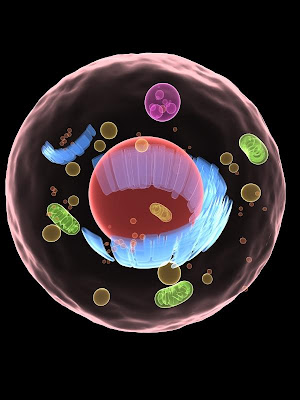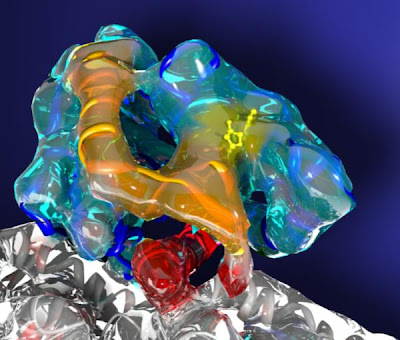Últimos assuntos
Tópicos mais visitados
Tópicos mais ativos

Cientistas lutam para erradicar linguagem teleológica
Página 1 de 1
19102010

 Cientistas lutam para erradicar linguagem teleológica
Cientistas lutam para erradicar linguagem teleológica

Pigliucci lança o INDEX PROHIBITORUM em biologia evolucionária: não usem linguagem teleológica
Terça-feira, Outubro 19, 2010
SCIENCE & EDUCATION
DOI: 10.1007/s11191-010-9267-6
Why Machine-Information Metaphors are Bad for Science and Science Education
Massimo Pigliucci and Maarten Boudry
Abstract
Genes are often described by biologists using metaphors derived from computational science: they are thought of as carriers of information, as being the equivalent of “blueprints” for the construction of organisms. Likewise, cells are often characterized as “factories” and organisms themselves become analogous to machines. Accordingly, when the human genome project was initially announced, the promise was that we would soon know how a human being is made, just as we know how to make airplanes and buildings. Importantly, modern proponents of Intelligent Design, the latest version of creationism, have exploited biologists’ use of the language of information and blueprints to make their spurious case, based on pseudoscientific concepts such as “irreducible complexity” and on flawed analogies between living cells and mechanical factories. However, the living organism = machine analogy was criticized already by David Hume in his Dialogues Concerning Natural Religion. In line with Hume’s criticism, over the past several years a more nuanced and accurate understanding of what genes are and how they operate has emerged, ironically in part from the work of computational scientists who take biology, and in particular developmental biology, more seriously than some biologists seem to do. In this article we connect Hume’s original criticism of the living organism = machine analogy with the modern ID movement, and illustrate how the use of misleading and outdated metaphors in science can play into the hands of pseudoscientists. Thus, we argue that dropping the blueprint and similar metaphors will improve both the science of biology and its understanding by the general public.
+++++
FREE PDF GRÁTIS 237.4 KB
+++++
NOTA DESTE BLOGGER:
O artigo de Pigliucci e Boudry mostra o grande desespero em que se encontra a Nomenklatura científica quanto ao avanço da teoria do Design Inteligente:
"...if we want to keep Intelligent Design out of the classroom, not only do we have to exclude the ‘theory’ from the biology curriculum, but we also have to be weary [sic] of using scientific metaphors that bolster design-like misconceptions about living systems. We argue that the machine-information metaphor in biology not only misleads students and the public at large, but cannot but direct even the thinking of the scientists involved, and therefore the sort of questions they decide to pursue and how they approach them."
Uau! O nome disso Pigliucci e Boudry é desespero e censura epistêmica, mas muito antes de vocês nós tivemos Crick e Dawkins:
1. "Biologists must constantly keep in mind that what they see was not designed, but rather evolved." — Francis Crick, in What Mad Pursuit (1990), 138.
2. "Biology is the study of complicated things that give the appearance of having been designed for a purpose." Richard Dawkins, in The Blind Watchmaker (New York: W.W. Norton & Company, ), p. 1.
Ora, se nada em biologia faz sentido a não ser à luz da evolução, por que esse desespero e formulação de um INDEX PROHIBITORUM linguístico para descrever cientificamente as coisas vivas???
Os cientistas não devem seguir as evidências aonde elas forem dar? Bacon recomendou ir à natureza e fazer perguntas para ela. São essas as respostas que os cientistas estão obtendo: complexidade irredutível de sistemas biológicos e informação complexa especificada?
Em ciência é proibido proibir...
Revolução energética [evolucionária] chave para a origem da vida complexa
Energy Revolution Key to Complex Life: Depends on Mitochondria, Cells' Tiny Power Stations
ScienceDaily (Oct. 21, 2010) — The evolution of complex life is strictly dependent on mitochondria, the tiny power stations found in all complex cells, according to a new study by Dr Nick Lane, from UCL (University College London), and Dr William Martin, from the University of Dusseldorf.

Artist's rendering of basic cell structure, including mitochondria. (Credit: iStockphoto/Sebastian Kaulitzki)
For 70 years scientists have reasoned that evolution of nucleus was the key to complex life. Now, in work published in Nature, Lane and Martin reveal that in fact mitochondria were fundamental to the development of complex innovations like the nucleus because of their function as power stations in the cell.
"This overturns the traditional view that the jump to complex 'eukaryotic' cells simply required the right kinds of mutations. It actually required a kind of industrial revolution in terms of energy production," explained Dr Lane.
At the level of our cells, humans have far more in common with mushrooms, magnolias and marigolds than we do with bacteria. The reason is that complex cells like those of plants, animals and fungi have specialized compartments including an information centre, the nucleus, and power stations -- mitochondria. These compartmentalised cells are called 'eukaryotic', and they all share a common ancestor that arose just once in four billion years of evolution.
...
"If evolution works like a tinkerer, evolution with mitochondria works like a corps of engineers," said Dr Martin.
...
Read more here/Leia mais aqui: Science Daily
+++++
Nature 467, 929-934 (21 October 2010) | doi:10.1038/nature09486; Published online 20 October 2010
The energetics of genome complexity
Nick Lane1 & William Martin2
Abstract
All complex life is composed of eukaryotic (nucleated) cells. The eukaryotic cell arose from prokaryotes just once in four billion years, and otherwise prokaryotes show no tendency to evolve greater complexity. Why not? Prokaryotic genome size is constrained by bioenergetics. The endosymbiosis that gave rise to mitochondria restructured the distribution of DNA in relation to bioenergetic membranes, permitting a remarkable 200,000-fold expansion in the number of genes expressed. This vast leap in genomic capacity was strictly dependent on mitochondrial power, and prerequisite to eukaryote complexity: the key innovation en route to multicellular life.
+++++
Professores, pesquisadores e alunos de universidades públicas e privadas com acesso ao site CAPES/Periódicos podem ler gratuitamente este artigo da Nature e de mais 22.440 publicações científicas.
+++++
ALÔ MEC/SEMTEC/PNLEM:
Se a hipótese de Lane e Martin estiver correta, isso significa que nossos livros terão, pelo menos, que mencionar esta nova hipótese como possível candidata a melhor explicar a origem da complexidade nas formas bióticas.
Eu gostei mesmo foi da declaração do Dr. Martin:
"If evolution works like a tinkerer, evolution with mitochondria works like a corps of engineers".
O Massimo Pigliucci, aquele que sugeriu um INDEX PROHIBITORUM de palavras que reflitam ideias de engenharia (teleologia) para evitar a interpretação científica errônea dos fatos científicos que ocorrem nas coisas bióticas, deve estar bufando de raiva com esta declaração de a evolução ser através de design inteligente...
Insight dentro do mecanismo molecular do motor multitarefa da kinesina-8: mero acaso, fortuita necessidade ou design inteligente?
The EMBO Journal (2010) 29, 3437 - 3447
doi:10.1038/emboj.2010.220
Published online: 3 September 2010
Insight into the molecular mechanism of the multitasking kinesin-8 motor
Carsten Peters1,3, Katjuša Brejc2,3,4,5, Lisa Belmont2, Andrew J Bodey1, Yan Lee2, Ming Yu2, Jun Guo2, Roman Sakowicz2, James Hartman2 and Carolyn A Moores1
Institute of Structural and Molecular Biology, Birkbeck College, London, UK
Cytokinetics, San Francisco, CA, USA
Correspondence to:
Carolyn A Moores, Institute of Structural and Molecular Biology, Birkbeck College, Malet Street, London WC1E 7HX, UK. Tel.: +44 207 631 6858; Fax: +44 207 631 6803; E-mail: c.moores@mail.cryst.bbk.ac.uk
3These authors contributed equally to this work
4Present address: Howard Hughes Medical Institute, University of California, Berkeley, CA 94720, USA
5Present address: Department of Molecular and Cell Biology, University of California, Berkeley, CA 94720, USA
Received 8 March 2010; Accepted 17 August 2010

Imagem not related to this article/Imagem não relacionada a este artigo.
Science Daily/Charles Sindelar, Brandeis University
Members of the kinesin-8 motor class have the remarkable ability to both walk towards microtubule plus-ends and depolymerise these ends on arrival, thereby regulating microtubule length. To analyse how kinesin-8 multitasks, we studied the structure and function of the kinesin-8 motor domain. We determined the first crystal structure of a kinesin-8 and used cryo-electron microscopy to calculate the structure of the microtubule-bound motor. Microtubule-bound kinesin-8 reveals a new conformation compared with the crystal structure, including a bent conformation of the α4 relay helix and ordering of functionally important loops. The kinesin-8 motor domain does not depolymerise stabilised microtubules with ATP but does form tubulin rings in the presence of a non-hydrolysable ATP analogue. This shows that, by collaborating, kinesin-8 motor domain molecules can release tubulin from microtubules, and that they have a similar mechanical effect on microtubule ends as kinesin-13, which enables depolymerisation. Our data reveal aspects of the molecular mechanism of kinesin-8 motors that contribute to their unique dual motile and depolymerising functions, which are adapted to control microtubule length.
Imagem not related to this article/Imagem não relacionada a este artigo.
Physical Review Focus
Keywords: cryo-electron microscopy, crystallography, cytoskeleton regulation, kinesin, microtubule
+++++
Professores, pesquisadores e alunos das universidades públicas e privadas com acesso ao site CAPES/Periódicos podem ler gratuitamente este artigo do The EMBO Journal e de mais 22.440 publicações científicas.
+++++
NOTA DESTE BLOGGER:
Apesar de Massimo Pigliucci ter sugerido recentemente um INDEX PROHIBITORUM para os cientistas evitarem utilizar linguagem descrevendo eventos biológicos em termos teleológicos (engenharia), esses aqui não puderam resistir e dizer outra coisa: existem sim sinais de inteligência e design, e eles são empiricamente detectados na natureza.
E os cientistas? Bem, os cientistas seguem as evidências aonde elas forem dar...

Eduardo- Mensagens : 5997
Idade : 54
Inscrição : 08/05/2010
 Tópicos semelhantes
Tópicos semelhantes» Evolução favorece aqueles que mais lutam contra a teoria da evolução
» Grandes cientistas cristãos
» A linguagem de aparência
» Linguagem distorcida
» Canto de pássaro, linguagem de gente
» Grandes cientistas cristãos
» A linguagem de aparência
» Linguagem distorcida
» Canto de pássaro, linguagem de gente
Permissões neste sub-fórum
Não podes responder a tópicos
 Início
Início








 Seja fã Forumeiros
Seja fã Forumeiros
» Acordem adventistas...
» O que Vestir Para Ir à Igreja?
» Ir para o céu?
» Chat do Forum
» TV Novo Tempo...
» Lutas de MMA são usadas como estratégia por Igreja Evangélica para atrair mais fiéis
» Lew Wallace, autor do célebre livro «Ben-Hur», converteu-se quando o escrevia
» Ex-pastor evangélico é batizado no Pará
» Citações de Ellen White sobre a Vida em Outros Planetas Não Caídos em Pecado
» Viagem ao Sobrenatural - Roger Morneau
» As aparições de Jesus após sua morte não poderiam ter sido alucinações?